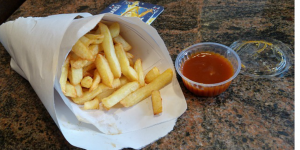
Sticking to a nutritious diet while traveling can be one of the more difficult things to do. However, if you learn how to make smart choices, a healthy diet is really not that difficult. It’s probably not the best time in which to start a healthy diet, but if you are currently making healthy choices in your foods already, modifying your diet slightly to accommodate travel, is not as difficult as it first may seem.
If you are traveling by airplane, your diet may have to include airplane food, which can often be of poor nutritional value, depending on the selection. When you book your flight, ask about your food options, ask if a vegetarian dish is available? Vegetarian dishes are sometimes more nutritional in this case, but it really depends on what they may be serving. If you can, eat a larger meal before your flight, so that you don’t have to eat the entire meal that is served, to feel full.
When driving or taking a bus, you may be tempted to stop at fast food restaurants and eat the meals found there. Avoid this whenever possible! If you’re on vacation, you may wish to splurge a tiny bit, but having fast food more than once during a week can really be bad for your health. If you must, choose the healthiest options available, like chicken breasts and diet soda.
Also, remember that you can take your own meals when traveling. Carrying a loaf of whole-wheat bread or pita wraps, some lean lunchmeat, and low-fat cheese in a cooler is a great way to avoid high-fat and high-cholesterol junk food meals. These are much better choices and you’ll save a lot of money as well. Call ahead to ask if there will be a refrigerator in your hotel room.
Lastly, make smart choices when you eat out. If you choose salads or pasta get the dressing on the side and ask about low-carb options. In fact, many places print these dieting options directly in the menu for the health-conscious people. Control your portions by ordering lunch menu sizes or splitting the meal in have and getting a doggie bag, and you’ll be well on your way to healthy eating, even away from home.
Yes, eating healthy foods when you travel can be a challenge. However, your health is worth it. Eating meals high in nutrition will also assist in fighting illnesses that you are likely to encounter when traveling and you will find yourself more alert so that you can enjoy your trip.

Everyone knows that sugar is not a good part of a healthy diet and so many people are turning to sugar substitutes in order to get their sweet tooth fulfilled, but, are these substitutes in reality better than sugar or are there more things hidden under the surface of these “healthier” alternatives than meets the eye?
Let’s take a closer look at some of these substitutes and see which ones are better and which ones may be better to avoid.
SUCRALOSE, sold under the name splenda, is useful as a one to one substitute for sugar. Sucralose is made from sugar and is used to make splenda which tastes like sugar. Sucralose has no calories but does not measure, look or act like sugar. Sucralose is 600xs sweeter than sugar so much less is needed for the same sweetness. Sucralose is bulked up with maltodextrin, a carbohydrate derived from corn, giving it some calories and making it look and act like sugar. This combination makes splenda. Splenda has 1/8 to 1/4 the calories of sugar. We are told that all the sucralose consumed will be excreted unused but despite the manufactures claims, sucralose is absorbed and metabolized by the body. The FDA’s “final rule” report says that 11% to 27% of sucralose is absorbed in humans and the Japanese food sanitation council says as much as 40% is absorbed.
SUCROSE is made from sugar beets or sugar cane. Not only does sucrose taste good, but it also gives you quick energy as well. However, the downside to this quick energy burst is that when it’s gone, your body wants another dose of sugar to keep the energy going. Taking in too much sucrose leads to excessive insulin responses, which causes the excess carbohydrates to be stored in your fat cells. Because sucrose is a high-glycemic (rapid release) sugar, you should substitute other sweeteners. Here are some other forms of sucrose to avoid when looking at labels: raw sugar, brown sugar, invert sugar, turbinado, confectioner’s sugar, cane sugar, crystallized cane juice.
ASPARTAME is about 200xs sweeter than sugar and there is a lot of concern over the safety of this sweetener. It is made from two amino acids, aspartic acid and phenylalanine. Aspartame is marketed under the names NutraSweet and equal and is found in a wide variety of prepared products. This sweetener is not useful for cooking or adding to hot beverages.
MALTITOL, like all sugar alcohols does not promote tooth decay and has a taste and sweetness like sugar. It does not raise blood sugar levels or insulin levels and is useful for diabetics. Like all sugar alcohols, maltitol can have a laxative effect in some people.
SACCHARINE has been around for almost 100 years and is 200xs sweeter than sugar. It is produced from a substance found in grapes. The human body cannot break it down, so it does not produce an insulin response. It is most commonly found in soft drinks and sweeteners like sweet n low.
SORBITOL is a sugar alcohol which is found in numerous products, especially those that need to become dry or hardened like candies or confectionaries. Sorbitol is often used in reduced calorie or light products.
HIGH FRUCTOSE CORN SYRUP is made from corn starch and has a high glycemic value which means it will cause a large insulin response. There is some controversy over the safety of using large amounts of this sweetener over time. High fructose corn syrup is found in numerous products and is not the same as a product that contains fructose.
FRUCTOSE, also known as fruit sugar, is sweeter than table sugar and only 1/3 is needed as a sugar substitute. Fructose is low on the glycemic index (slow release sugar) and so it helps control insulin responses, keeping them low, which means it is good for diabetics.
DEXTROSE OR GLUCOSE, has a higher glycemic value than table sugar and on most glycemic indexes, glucose is used to compare the value of other “foods” as glucose (which is actual blood sugar) has a faster release into your system than most any other sugar or food item which will result in a very sharp rise in your insulin levels. Diabetics should not use this sweetener. On labels it can also be called corn sugar.
LACTOSE, also known as milk sugar is about half way between sucrose and fructose on the glycemic index. It is made from whey and skim milk and is used largely by the pharmaceutical industry.
HONEY, is an invert sugar formed by an enzyme from nectar. It is a combination of fructose, sucrose, glucose and maltose and is a high glycemic sweetener so it should be avoided by diabetics who need to control insulin. Unlike popular belief’s, honey only contains trace amounts of vitamins and minerals.
As you can see, some sugars and substitutes can be fine to use in place of table sugar but certainly NOT all of them. For diabetics or people trying to control their insulin for fat loss, careful consideration must be taken when using sweeteners or sweetened products. As for the rest of us, well, still we need to be aware of what kind of sweeteners we consume as you cannot always rely on claims made by manufactures of some sweeteners or products which contain sweeteners regarding there safety or health benefits.

Have you been wondering what healthy dieting is all about? It is a way to slim down and keep your weight within optimal limits making you fit. It is very safe and efficient. The following tips on healthy dieting will help you to get you where you should be.
You should always eat healthy foods and avoid calorie-rich foods. Healthy foods include the following: vegetables, fruits, legumes, whole grain cereals, low-fat dairy products, paste and bread. Fish, chicken, and lean beef are also good for you in small portions. Avoid junk food, fast food, fried foods and sugary foods. These are the fundamentals of healthy dieting.
Downsize your portions. This healthy dieting tip has to do with calories as well. The smaller the portions you eat, the lower the calorie count, is, all other things being equal. You can enjoy smaller portions by having a three-dish meal with a small main dish, a fresh salad, and a fruit dessert. Another trick is to have a glass of water or two before sitting at the table.
Have four to five meals a day for healthy dieting and effective weight loss. When you starve for considerable periods of time, your blood sugar levels fall. In turn, you get to experience hunger pangs and strong cravings that are hard to handle. At your next meal, you tend to eat a lot more than you need to. The best solution to this problem is to enjoy one snack in the morning and one in the afternoon between meals. These can be very light. Low-fat, sugar-free yogurt, raw nuts, and fruits are among the best choices.
Cook your meals by yourself. This is essential for healthy dieting. In this way, you can choose only fresh and healthy ingredients. You will have the opportunity to use recipes that require very little oil for cooking. You will enjoy healthy dishes instead of fried foods. Cooking your meals will allow you to make any dish super delicious by using different herbs and spices. As you certainly know, delicious dishes bring you greater satisfaction and allow you to eat less.
Reduce stress in your life as much as you can. Stress makes us eat more or eats less. That is the reason why it is one of the main enemies of healthy dieting. Various stress relief methods produce excellent results and that you can readily enjoy. The most popular ones include yoga, meditation, gardening and spa treatments. In general, any exercise is good for relieving stress as well.
Exercise regularly for healthy dieting. It is not only about the calories you intake with food but also about the calories you burn. Some cardio exercises like jogging, swimming, and cycling, are the most efficient for weight loss and general fitness. It is best to work out for up to an hour every other day. In this way, you will burn fat and not protein that your body needs. You will let your body recover from the exercise stress effectively. Make sure you warm up and cool down to avoid injuries.
Now you know how to go about healthy dieting. Remember that these are the fundamentals that will give you a head start and provide for getting excellent results. By learning more about the subject, you will be able to maintain these results for good.



